If you’ve ever struggled with heavy, compacted, and poorly draining soil, chances are you’re dealing with clay soil. While clay soil can be rich in nutrients, it also presents challenges that can make gardening frustrating. Poor drainage, difficulty in root penetration, and a tendency to become rock-hard when dry or sticky when wet are common issues. The good news? With the right techniques, you can transform clay soil into a loose, well-draining, and productive growing medium.
In this post, we’ll explore effective methods for improving clay soil, enhancing drainage, and boosting aeration so your plants can thrive.
Understanding Clay Soil: Challenges and Benefits
Clay soil is made up of tiny, densely packed particles that hold onto water and nutrients. While this can be beneficial for plant growth, it also creates problems:
Common Problems with Clay Soil:
-
Poor Drainage: Water drains slowly, leading to soggy soil and root rot.
-
Compaction: Clay becomes hard and dense, making it difficult for roots to grow and air to circulate.
-
Cracking When Dry: When clay dries out, it can form deep cracks, making it difficult for new plants to establish roots.
-
Sticky and Heavy to Work With: Clay soil clumps together when wet, making it difficult to dig or till.
Benefits of Clay Soil:
-
Rich in Nutrients: Clay retains essential minerals better than sandy soils.
-
Good Water-Holding Capacity: While excessive water retention is an issue, clay soil holds moisture well in dry conditions.
-
Can Be Improved: Unlike sandy soil, which struggles to hold nutrients, clay soil can be amended to improve its structure and drainage.
Methods for Improving Clay Soil
1. Add Organic Matter (The Best Long-Term Solution)
The single most effective way to improve clay soil is to incorporate organic matter. Organic materials help separate clay particles, improving drainage and aeration while providing nutrients to plants.
Best Organic Amendments for Clay Soil:
-
Compost: Decomposed plant material improves soil texture and provides essential nutrients.
-
Aged Manure: Well-rotted manure helps break up heavy soil and enriches it with nutrients.
-
Leaf Mold: Decomposed leaves add structure and moisture-retaining benefits.
-
Coconut Coir or Peat Moss: Helps lighten clay soil while improving its ability to retain air and moisture.
How to Apply Organic Matter:
-
Spread 2 to 4 inches of organic matter on top of the soil.
-
Use a garden fork or broadfork to mix it into the top 6 to 8 inches of soil.
-
Repeat annually for continuous soil improvement.
2. Avoid Over-Tilling and Compaction
Tilling clay soil when it’s wet can cause it to become even more compacted. Instead, use a broadfork or garden fork to aerate the soil without breaking down its structure.
Best Practices:
-
Work the soil when it's slightly moist, not wet. If soil sticks to your shovel, wait for it to dry out slightly.
-
Avoid walking on garden beds. Use stepping stones or designated paths to prevent compaction.
-
Use raised beds if your soil remains too compacted.
3. Improve Drainage with Cover Crops and Deep-Rooted Plants
Cover crops and deep-rooted plants can naturally break up compacted clay soil while adding organic matter.
Best Plants for Breaking Up Clay Soil:
-
Daikon radish (also called tillage radish) – Deep roots penetrate clay and decompose, improving soil structure.
-
Clover and vetch – Fix nitrogen into the soil while loosening compacted layers.
-
Sunflowers and alfalfa – Develop deep taproots that help aerate and improve drainage.
Planting a cover crop in the off-season and tilling it into the soil as green manure helps improve soil texture over time.
4. Use Mulch to Protect the Soil Surface
Applying a 2 to 3-inch layer of mulch helps prevent clay soil from drying out, cracking, and compacting.
Best Mulch for Clay Soil:
-
Wood chips or bark mulch (slowly breaks down and improves soil structure).
-
Straw or shredded leaves (adds organic matter while regulating moisture).
-
Grass clippings (use thin layers to prevent matting).
Mulching also encourages earthworm activity, which naturally aerates and improves soil quality.
5. Add Gypsum (For Extreme Cases of Clay Compaction)
Gypsum (calcium sulfate) is sometimes recommended for breaking up heavy clay soil. It works by flocculating clay particles, improving soil structure and drainage.
When to Use Gypsum:
-
If your soil is highly compacted and has high sodium levels.
-
If soil tests indicate a calcium deficiency.
How to Apply Gypsum:
-
Apply 20-40 lbs per 1,000 square feet and water it in.
-
Do not expect immediate results—gypsum works gradually over several months.
Note: Gypsum does not work in all clay soils and is unnecessary unless a soil test confirms sodium or calcium imbalances. Organic matter remains the best long-term solution.
6. Create Raised Beds for Immediate Results
If improving your clay soil feels like a long-term project, consider building raised beds filled with high-quality soil and compost. Raised beds improve drainage, reduce compaction, and allow for better control over soil conditions.
What to Avoid When Improving Clay Soil
-
Avoid adding sand alone. Sand and clay can combine to form a cement-like texture. If using sand, mix it with large amounts of organic matter.
-
Don’t overwork wet clay soil. This makes compaction worse.
-
Avoid excessive fertilizer use. Clay soil holds onto nutrients better than sandy soil, so over-fertilizing can lead to imbalances.
Patience Pays Off: Improving Clay Soil Takes Time
Transforming heavy clay soil into rich, well-draining garden soil doesn’t happen overnight, but with consistent effort, you’ll see improvements year after year. The key is to continually add organic matter, avoid compaction, and use deep-rooted plants to work the soil naturally.
By following these steps, you’ll create healthier soil that supports strong root growth, better water infiltration, and thriving plants.

Comments
No comments yet. Be the first to comment!
You must be logged in to comment. Login